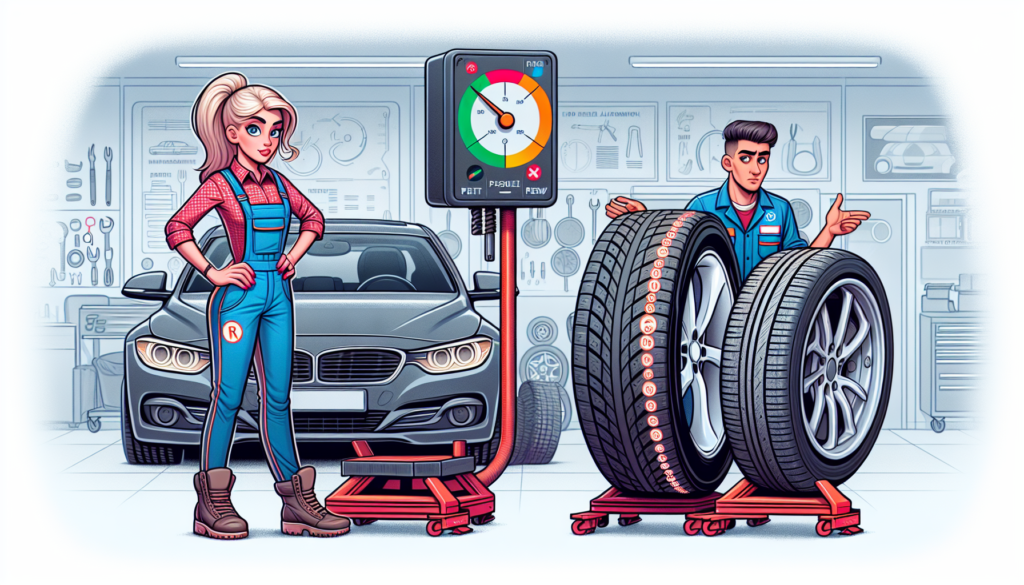Have you ever wondered how wheel alignment affects the lifespan of your tires? It’s a question that many car owners have, as proper wheel alignment plays a crucial role in maintaining the health and longevity of your tires. When your wheels are out of alignment, it can cause uneven tire wear, leading to premature tire replacement and increased expenses. In this article, we’ll explore the various ways in which wheel alignment impacts tire longevity, allowing you to make informed decisions and take proactive steps to ensure your tires last as long as possible. So, let’s dive into the world of wheel alignment and discover its impact on your tires!

Effects of Misaligned Wheels on Tire Longevity
Uneven Tire Wear
Misaligned wheels can lead to uneven tire wear, which significantly affects tire longevity. When wheels are not properly aligned, certain areas of the tire bear more weight and friction than others. This uneven distribution of forces causes the tire to wear down unevenly. As a result, the tire tread wears down faster, leading to a reduced lifespan and the need for premature replacement.
Increased Tire Rolling Resistance
When wheels are misaligned, the tires experience increased rolling resistance. This means that it takes more effort and energy for the tires to move and maintain vehicle speed. The increased rolling resistance puts additional strain on the tires, causing them to wear out more quickly. As a result, the lifespan of the tires is shortened, and they will need to be replaced sooner than expected.
Reduced Tire Lifespan
Overall, misaligned wheels can significantly reduce the lifespan of tires. The combination of uneven tire wear and increased rolling resistance puts excessive stress on the tires. As a result, the tires wear out faster and need to be replaced more frequently. Proper wheel alignment is essential to maintain tire longevity and avoid unnecessary expenses.
Factors Affecting Wheel Alignment
Road Conditions
The quality of the roads you drive on can impact the alignment of your wheels. Potholes, bumps, and other irregularities in the road surface can knock your wheels out of alignment. It is important to drive carefully and avoid rough road conditions whenever possible to minimize the risk of misaligned wheels.
Driving Habits
Your driving habits can also affect wheel alignment. Aggressive driving, such as hitting curbs, taking sharp turns at high speeds, and driving over speed bumps too quickly, can cause your wheels to become misaligned. It is crucial to drive responsibly and avoid actions that could lead to misalignment.
Suspension System Wear
The condition of your vehicle’s suspension system can impact wheel alignment. Over time, components of the suspension system can wear down or become damaged, leading to misalignment. Regular maintenance and inspections of the suspension system can help detect and address any issues early on, minimizing the risk of misaligned wheels.
Accidents or Collisions
Accidents or collisions can have a significant impact on wheel alignment. Even a minor collision can cause the wheels to become misaligned. It is crucial to have your wheel alignment checked after any collision or accident, no matter how small, to ensure your wheels are properly aligned and prevent any adverse effects on tire longevity.
Importance of Proper Wheel Alignment
Optimal Tire Performance
Proper wheel alignment is essential for optimal tire performance. When wheels are aligned correctly, the tires make even contact with the road surface, allowing them to perform at their best. This results in better traction, improved handling, and enhanced overall performance, ensuring your tires last longer.
Enhanced Fuel Efficiency
Misaligned wheels can lead to increased rolling resistance, which negatively impacts fuel efficiency. When the tires have to overcome more resistance to move, it requires more energy from the engine, resulting in higher fuel consumption. Proper wheel alignment reduces rolling resistance, allowing the tires to move more efficiently and improve fuel efficiency.
Improved Handling and Stability
Wheel alignment greatly influences the vehicle’s handling and stability. When the wheels are properly aligned, the vehicle responds more accurately to steering inputs and maintains stability on the road. Misaligned wheels, on the other hand, can cause the vehicle to pull to one side, making it harder to control. Proper alignment ensures a smoother and safer driving experience while minimizing tire wear and tear.
Signs of Misaligned Wheels
Vehicle Pulling to One Side
One of the most common signs of misaligned wheels is when your vehicle pulls to one side while driving. If you notice that your vehicle tends to veer off to one direction even when driving on a straight road, it could indicate a need for wheel alignment.
Uneven or Rapid Tire Wear
Inspecting your tires regularly can help identify misalignment issues. Uneven tire wear, where certain areas of the tire tread are significantly more worn than others, is a clear indication of misaligned wheels. If you notice rapid or unexpected tire wear, it is crucial to have your wheels aligned to prevent further damage and maximize tire longevity.
Steering Wheel Vibration
A vibrating steering wheel can also be a sign of misaligned wheels. When the wheels are not aligned properly, they may cause vibrations that can be felt through the steering wheel while driving. If you experience persistent steering wheel vibrations, it is important to have your wheel alignment checked to ensure a smoother and safer driving experience.
Crooked Steering Wheel
Another indication of misaligned wheels is a crooked steering wheel when driving straight. If you notice that your steering wheel is not centered and is slightly turned to one side even when driving on a straight road, it could be due to misaligned wheels. This issue should be addressed promptly to avoid further complications and unnecessary wear on tires.

Wheel Alignment Procedures
Initial Inspection and Diagnosis
The first step in the wheel alignment process is an initial inspection and diagnosis. A qualified technician will inspect the tires, suspension system, and other components to identify any signs of misalignment or other issues. Using specialized tools and equipment, they will assess the angles of the wheels and determine the adjustments needed.
Adjustment of Caster, Camber, and Toe Angles
Once the misalignment is identified, the technician will proceed to adjust the caster, camber, and toe angles of the wheels. These angles affect how the tires make contact with the road surface and how the vehicle handles. The technician will make precise adjustments to ensure the wheels are aligned to the manufacturer’s specifications.
Regular Maintenance and Check-ups
Regular maintenance and check-ups are essential for maintaining proper wheel alignment. It is recommended to have your wheel alignment checked at least once a year or whenever you notice any signs of misalignment. Routine inspections allow technicians to detect and correct any misalignment issues early on, preserving tire longevity and overall vehicle performance.
Alignment Methods: Two-Wheel vs. Four-Wheel
Two-Wheel Alignment
Two-wheel alignment, also known as front-end alignment, focuses on aligning the front wheels of the vehicle. This method is suitable for vehicles where the rear wheels do not have adjustable alignment angles. Two-wheel alignment is more common in older vehicles, but it may still be necessary for certain vehicles with rear-wheel drive or solid rear axles.
Four-Wheel Alignment
Four-wheel alignment, also known as all-wheel alignment, aligns all four wheels of the vehicle. This method is suitable for vehicles with adjustable rear alignment angles, such as most modern cars and trucks. Four-wheel alignment provides more comprehensive alignment adjustments, ensuring proper alignment of all wheels for optimal tire longevity and performance.
Benefits and Limitations of Each Method
Two-wheel alignment is typically less expensive and quicker to perform compared to four-wheel alignment. However, it only addresses the alignment of the front wheels, potentially leaving the rear wheels misaligned. Four-wheel alignment, on the other hand, ensures proper alignment of all wheels, maximizing tire longevity and overall vehicle performance. The choice between the two methods depends on the specific vehicle and its alignment requirements.

Professional Wheel Alignment vs. DIY
Expertise and Equipment
Professional wheel alignment is generally recommended due to the expertise and specialized equipment required. Trained technicians have the knowledge and experience to accurately diagnose and correct wheel alignment issues. They use advanced alignment machines, ensuring precise adjustments to the angles of the wheels. DIY alignment methods, though possible, often lack the necessary tools and expertise to achieve the same level of precision.
Precision and Accuracy
Professional wheel alignment offers greater precision and accuracy compared to DIY methods. Trained technicians can fine-tune the alignment angles to perfectly align the wheels as per the manufacturer’s specifications. DIY methods, such as using string or laser alignment tools, may not provide the same level of accuracy, resulting in suboptimal alignment and potential tire wear issues.
Cost Considerations
While professional wheel alignment may come with a cost, it is important to consider the long-term benefits and potential savings it offers. Improper wheel alignment can lead to excessive tire wear and premature replacement, resulting in increased expenses. Investing in professional wheel alignment not only extends tire longevity but also improves fuel efficiency and overall vehicle performance, potentially offsetting the initial cost.
Frequency of Wheel Alignment
Manufacturer Recommendations
Manufacturers typically provide recommendations for wheel alignment intervals in the vehicle’s owner’s manual. These guidelines often suggest having the wheel alignment checked annually or every 10,000 to 12,000 miles, depending on driving conditions and other factors. Following the manufacturer’s recommendations ensures proactive maintenance and helps maximize tire longevity.
Driving Conditions
Driving conditions can affect how frequently wheel alignment should be performed. If you frequently drive on rough or poorly maintained roads, it can increase the risk of misalignment. In such cases, more frequent wheel alignment checks may be necessary to compensate for the impact of adverse road conditions on the alignment.
Suspension System Wear
The condition of your vehicle’s suspension system can also impact the frequency of wheel alignment. Worn suspension components or other issues in the suspension system can lead to misalignment. If you notice signs of suspension system wear, such as uneven tire wear or handling issues, it is important to have your wheel alignment checked promptly.

Wheel Alignment and Tire Rotation
Complementary Maintenance Practices
Wheel alignment and tire rotation are complementary maintenance practices that work together to maximize tire longevity. While wheel alignment ensures proper alignment of the wheels, tire rotation involves moving the tires to different positions on the vehicle. This helps even out tire wear, as different tires may wear at different rates depending on their positions.
Maximizing Tire Lifespan
By regularly aligning your wheels and rotating your tires, you can maximize the lifespan of your tires. Proper wheel alignment prevents uneven tire wear, while tire rotation allows for balanced wear across all tires. This combination helps extend tire longevity and ensures you get the most out of your investment in tires.
Conclusion
Proper wheel alignment is crucial for tire longevity and overall vehicle performance. Misaligned wheels can cause uneven tire wear, increased rolling resistance, and reduced tire lifespan. Factors such as road conditions, driving habits, suspension system wear, and accidents can all contribute to misalignment. It is important to be aware of the signs of misaligned wheels, such as vehicle pulling, uneven tire wear, steering wheel vibrations, and a crooked steering wheel.
Wheel alignment procedures involve initial inspection and diagnosis, adjustment of caster, camber, and toe angles, and regular maintenance check-ups. Two-wheel and four-wheel alignment methods are available, each with their own benefits and limitations. While professional wheel alignment is recommended for precision and expertise, DIY methods can be attempted with caution.
The frequency of wheel alignment depends on manufacturer recommendations, driving conditions, and suspension system wear. Regular alignment, combined with tire rotation, maximizes tire lifespan and promotes optimal tire performance. Investing in proper wheel alignment not only extends tire longevity but also improves fuel efficiency and enhances handling and stability.
By prioritizing wheel alignment, you can ensure your tires last longer, save on unnecessary expenses, and enjoy a smoother and safer driving experience.


